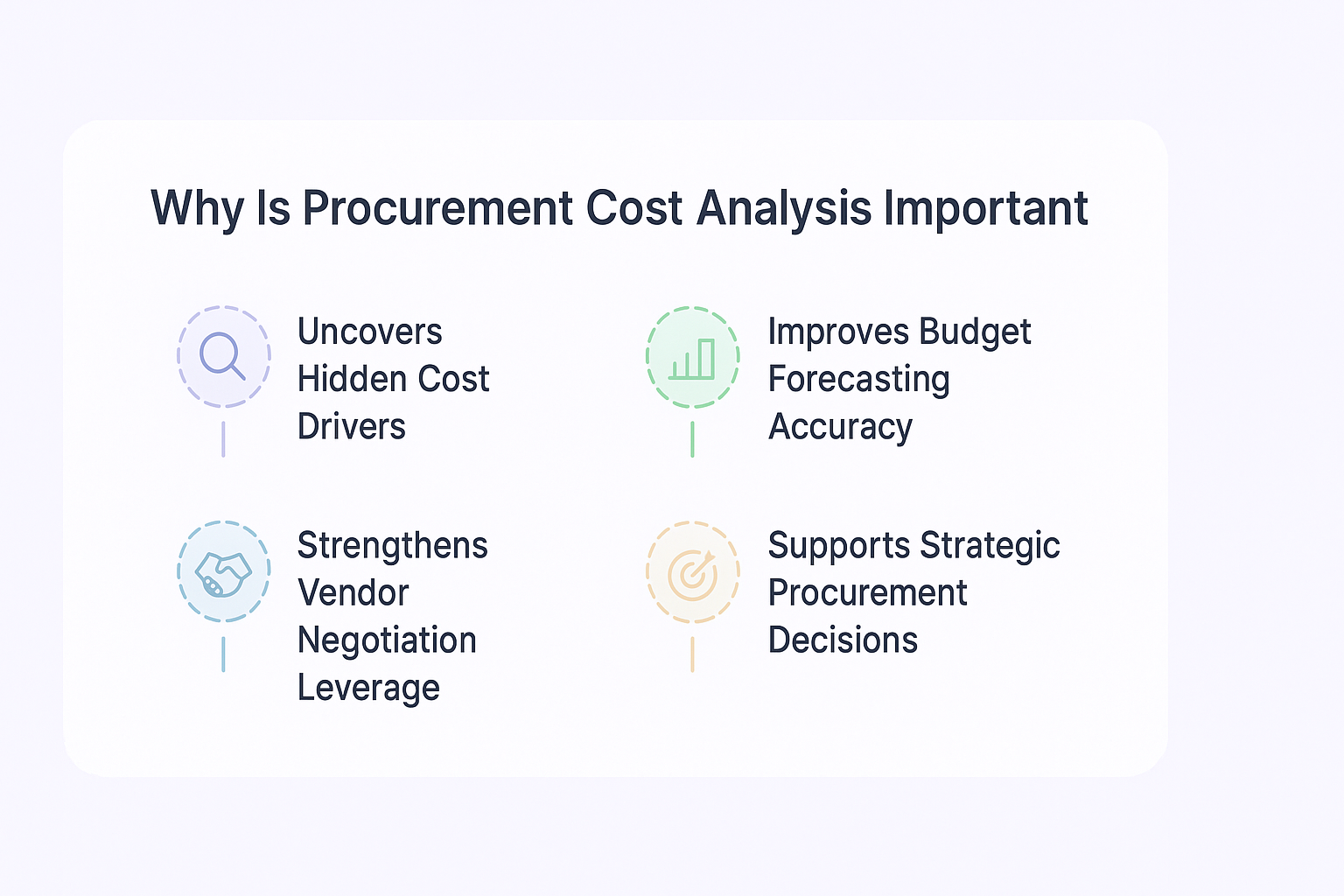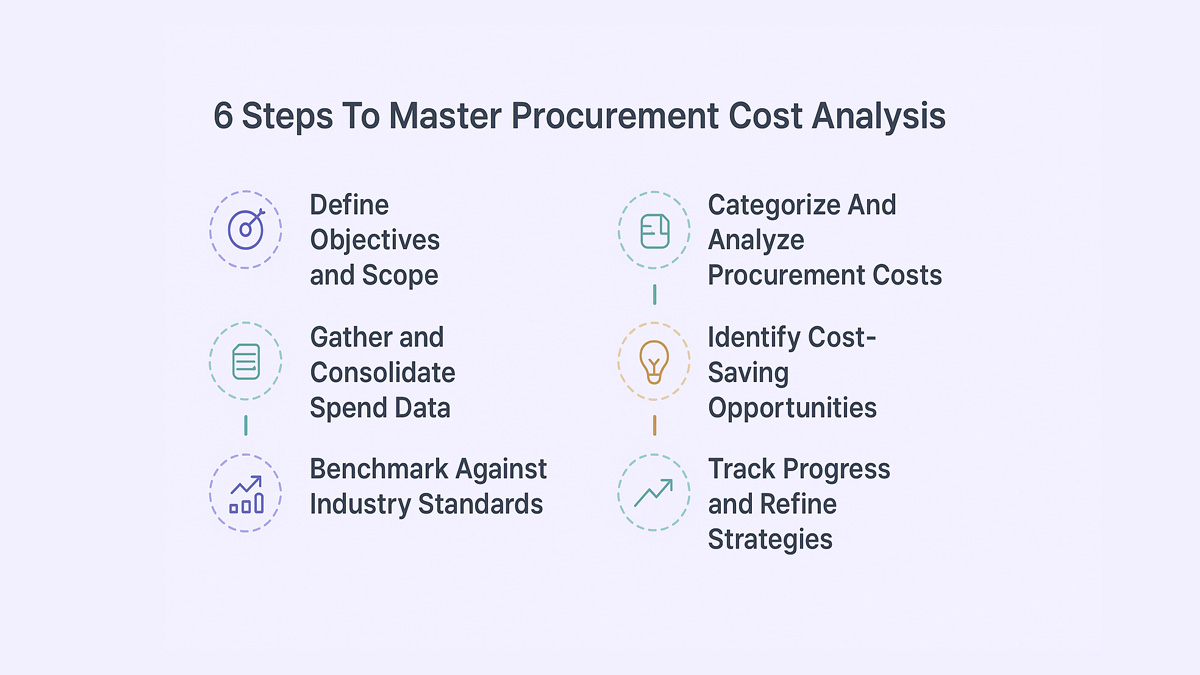

6 Surprising Steps to Master Procurement Cost Analysis (Most Teams Miss #4!)

6 Surprising Steps to Master Procurement Cost Analysis (Most Teams Miss #4!)
Learn six key steps to master procurement cost analysis and drive savings, visibility, and better supplier decisions.


According to Deloitte, nearly 30% of procurement budgets go unaccounted for due to poor visibility and fragmented data. That’s money that could have been saved, reinvested, or used for growth.
Understanding where your spending goes and why is no longer optional. It’s the first step toward building a smarter, more accountable procurement process. Let’s look at how procurement cost analysis helps you find what’s slipping through the cracks and turn it into measurable savings.
What is Procurement Cost Analysis?
Procurement cost analysis is the process of reviewing and assessing all expenses involved in purchasing goods or services. It helps identify cost-saving opportunities, improve purchasing efficiency, and support better sourcing decisions by analyzing both direct and indirect costs.
Why is Procurement Cost Analysis Important
Procurement cost analysis is not just about finding cheaper vendors - it’s about understanding the full cost landscape, uncovering inefficiencies, and making smarter choices that go beyond price tags. When executed well, it becomes a strategic enabler for business growth and financial control.

Here are some of the reasons procurement cost analysis matters more than you think:
Uncovers Hidden Cost Drivers
Not all procurement costs are visible on the invoice. Things like delivery delays, poor-quality goods, or complex onboarding processes inflate the total cost of ownership. Cost analysis sheds light on these hidden drivers so businesses can address them proactively.
Improves Budget Forecasting Accuracy
Accurate cost analysis feeds into better forecasting. By understanding cost trends, seasonality, and supplier behaviors, finance and procurement teams can predict future expenditures with greater confidence - leading to tighter budgets and fewer surprises.
Strengthens Vendor Negotiation Leverage
Knowledge is power during negotiation. A detailed breakdown of past spending, price trends, and volume fluctuations gives your team solid ground to negotiate better rates or terms, especially when approaching contract renewals or consolidating suppliers.
Supports Strategic Procurement Decisions
Beyond cost-cutting, analysis helps procurement leaders align purchases with business goals. It enables smarter make-or-buy decisions, identifies strategic suppliers, and helps prioritize high-value categories for deeper sourcing efforts. Improved procurement decisions also lead to healthier cash flow by optimizing payment terms and reducing unnecessary spend. Strong supplier relationships are also essential for building long-term trust and ensuring consistent service quality.
Cost Analysis vs. Price Analysis: The Core Difference
Cost and Price Analysis are two core approaches to evaluating supplier quotes in procurement. Both aim to ensure fair pricing, improve negotiation outcomes, and guide Total Cost of Ownership (TCO) decisions. The key difference lies in what is being examined internal cost details versus external pricing data.
Difference
The Cost Breakdown Model: Components and Drivers
A Cost Breakdown Model (CBM) helps procurement teams see how a supplier’s total price is built. By analyzing each part of the cost, you can identify major cost drivers, compare suppliers more accurately, and make informed sourcing decisions. It’s a simple yet powerful way to bring transparency and control into purchasing.
Five Key Components of the Cost Breakdown Model
1. Material Costs: These include the raw materials, components, and parts needed to produce the final product. Monitoring Material Costs helps spot opportunities to save through bulk purchasing or alternate suppliers.
2. Labor Costs: Labor Costs cover wages, benefits, and other employee-related expenses that go into production. Understanding this component gives you insight into a supplier’s efficiency and automation levels.
3. Overhead Costs: Overhead Costs represent indirect expenses like rent, utilities, and maintenance. Tracking them ensures suppliers are not inflating prices through unnecessary administrative charges.
4. Profit Margins: This is the supplier’s markup added to cover business growth and sustainability. Comparing Profit Margins across vendors can reveal negotiation opportunities and pricing fairness.
5. Logistics and Transportation: This includes all expenses tied to shipping, handling, and delivery. Since these are often major cost drivers, especially in global sourcing, optimizing logistics can directly impact total spend.
Common Challenges In Procurement Cost Analysis
Understanding where the roadblocks lie is the first step to solving them. Here are three common challenges procurement teams face, and how to overcome them.
1. Scattered and Inconsistent Data
Challenge: Procurement data often lives in multiple systems, ERPs, spreadsheets, finance tools, and even email. Without consistent formats or naming standards, teams struggle to get a clear view of spending. This lack of visibility makes accurate analysis nearly impossible.
Solution: Centralize procurement data into one unified platform. Use automation or AI-based tools to standardize records and track spending across all categories. When data is clean and consistent, analysis becomes faster, clearer, and more reliable.
2. Misalignment Across Departments
Challenge: Procurement, finance, and operations teams often work toward different goals. Procurement focuses on savings, finance on compliance, and operations on speed. This misalignment causes fragmented communication, duplicated efforts, and slower decision-making.
Solution: Create shared KPIs and integrated workflows that connect all departments. Regular cross-functional reviews help align goals and ensure every team is working toward a single source of truth for spending data.
3. Overlooked Indirect Spend
Challenge: Indirect spend, like software subscriptions, freelancers, or office supplies, often slips under the radar. Since these purchases are decentralized, small costs add up over time, leading to budget leakage.
Solution: Bring indirect spend under the same analysis framework as direct spend. Use procurement cost analysis tools to track every category and identify savings opportunities that were previously hidden.
6 Steps To Master Procurement Cost Analysis
Procurement cost analysis isn’t just about slicing and dicing spend data. It’s about creating a systematic, repeatable process that surfaces actionable insights - so you can cut waste, negotiate smarter, and align procurement with broader business goals. Below are six practical steps that’ll help you move from reactive reporting to proactive savings.

1. Define Objectives and Scope
Don’t start with spreadsheets - start with a question. What exactly do you want to uncover or improve? Whether it’s optimizing a high-spend category, evaluating supplier efficiency, or trimming the tail-end spend, a clear objective will sharpen your analysis and help others rally behind it.
Remember to:
- Clarify whether your focus is tactical (like identifying savings) or strategic (like supplier rationalization)
- Limit the scope by region, business unit, or spend threshold to avoid data overwhelm
- Align your goals with internal stakeholders - finance, operations, or department leads
2. Gather and Consolidate Spend Data
Your insights are only as good as your inputs. That’s why this step often takes the most time - and delivers the most value. Pull data from all sources that touch purchasing: procurement tools, accounting systems, spreadsheets, even emails if needed. The goal is to bring every cost into one central view.
Remember to:
- Include hidden costs like freight charges, maintenance fees, taxes, or early payment penalties
- Normalize vendor names (e.g., “IBM Corp.” and “IBM Corporation” should map to one record)
- Spot data gaps early so you’re not cleaning while analyzing
3. Categorize And Analyze Procurement Costs
Think of this step as building a map. Once spend is categorized properly - by department, supplier, or product - you can begin spotting inefficiencies, anomalies, or fragmentation that were otherwise hidden.
Remember to:
- Use a standardized taxonomy for consistency across business units
- Visualize spend breakdowns to identify high-cost vendors or outlier purchases
- Investigate indirect spend categories like office supplies or marketing, which often escape scrutiny (Similarly, inefficient inventory management can distort actual demand and inflate procurement costs.)
4. Identify Cost-Saving Opportunities
Once patterns emerge, zoom in. Are you paying different rates to the same vendor across teams? Identifying and reducing overhead costs like administration or delayed payments can lead to immediate savings. Are you still being charged for licenses no one uses? These are your gold mines. Cost-saving opportunities often lie in fragmented spend, under-leveraged volume, and poorly negotiated contracts.
Remember to:
- Prioritize areas with high spend and low visibility
- Look for duplicate tools or services that could be consolidated
- Reassess vendor SLAs and payment terms to renegotiate on stronger footing
5. Benchmark Against Industry Standards
Internal insights are useful - but external context turns them into leverage. By benchmarking your costs against peers or industry averages, you validate your findings and strengthen your negotiating hand.
Remember to:
- Use procurement networks, analyst reports, or third-party databases to access benchmark data
- Compare not just price, but service quality, delivery timelines, and total value
- Share benchmark findings with leadership to support strategic sourcing decisions
6. Track Progress and Refine Strategies
Cost analysis is not a one-and-done exercise - it’s a muscle. To stay ahead, you need to continuously monitor results, adjust your strategy, and build a rhythm into your procurement processes. Over time, this approach becomes a core part of your cost governance model.
Remember to:
- Set up dashboards and KPIs to measure savings, vendor performance, and compliance (A robust supplier management process ensures these metrics translate into improved outcomes across the board.)
- Schedule quarterly or semi-annual reviews with department heads
- Use insights to inform budgeting, forecasting, and supplier scorecards
Best Practices For Effective Cost Analysis
The most successful procurement teams don’t just analyze spend - they build a system around it. These five best practices ensure that cost analysis doesn’t sit in a report, but actually drives measurable impact.
1. Centralize Procurement Data
Unify all spend, contract, and supplier data into a single system or dashboard. This creates one source of truth that reduces duplication, improves visibility, and makes analysis more actionable across teams.
2. Automate the Analysis Process
Use tools that automate categorization, flag anomalies, and track savings over time. Modern procurement software simplifies this by providing real-time dashboards and automated reports. Automating repetitive tasks reduces human error and frees up your team to focus on strategy instead of cleaning spreadsheets.
3. Involve Cross-Functional Stakeholders
Bring finance, operations, and department leads into the process early. Their collaboration is especially useful when navigating complex contract management scenarios. Their input adds context to the numbers, helps validate insights, and builds the trust needed to turn analysis into action.
4. Review and Update Categories Regularly
Your cost categories should evolve with the business. As new tools, vendors, or services are added, make sure your taxonomy reflects reality. Stale categories can hide savings opportunities or distort spend patterns.
5. Focus on Total Cost of Ownership (TCO)
Don’t just look at unit price - consider the full lifecycle cost. That includes onboarding, support, training, delays, and even contract exit penalties. TCO gives you a more realistic view of value than sticker price alone.
Mastering Should-Cost Analysis (SCA) in Procurement
The Purpose of Should-Cost Analysis
Should-Cost Analysis (SCA) is a strategic approach in procurement that defines what a product or service should cost under efficient conditions. It helps buyers estimate a fair price by analyzing the cost of materials, labor, overhead, and profit margins.
In simple terms, SCA in Procurement sets a cost benchmark at a realistic price point based on how efficiently a supplier could operate, not just what they quote. This gives procurement teams a stronger position in negotiations and prevents overpaying due to inflated supplier estimates.
Key Steps in a Should-Cost Analysis
To make Should-Cost Analysis effective, procurement teams usually follow three core steps:
1. Input Study: Gather all relevant inputs, material specifications, labor rates, production time, and logistics costs. The goal is to capture every variable that influences total cost.
2. Process Mapping: Understand each step of the supplier’s production process. Process mapping shows where inefficiencies may exist, helping you benchmark what an optimized process should look like.
3. Cost Modeling: Build a cost model using the gathered data. This model estimates the expected cost of production under ideal conditions and acts as a baseline for comparison. Effective cost modeling turns assumptions into measurable data, helping you negotiate with confidence.
Should Cost Negotiation
Once your SCA data is ready, it’s time to apply fact-based negotiation. Instead of debating prices abstractly, procurement teams use SCA results to discuss specific cost elements, materials, labor, or process inefficiencies, with suppliers.
This Should Cost Negotiation method creates transparency, builds credibility, and drives win-win outcomes. It helps suppliers see where cost improvements are possible, while ensuring your organization pays a fair and justified price.
How Spendflo Helps With Procurement Cost Analysis
Procurement teams lose thousands every year because disconnected systems hide overspending and missed renewals. A leading SaaS company once faced this challenge managing over 80 vendor contracts across spreadsheets. After switching to Spendflo, they gained full visibility, identified duplicate tools, and saved over $450,000 in annual SaaS costs within months.
If your cost analysis still relies on manual tracking or scattered data, you’re leaving money on the table. Spendflo unifies contracts, spend data, and vendor intelligence into a single platform, turning complex analysis into confident, data-backed decisions.
Don’t let inefficiency drain your budget, book a free demo today and see how Spendflo transforms procurement cost analysis into real savings.
Frequently Asked Questions on procurement cost analysis
What are the key components of procurement cost analysis?
At its core, procurement cost analysis includes spend data collection, cost categorization, supplier performance review, and total cost of ownership evaluation. It also involves benchmarking and identifying savings opportunities.
How does automation impact procurement cost analysis?
Automation accelerates the process by reducing manual tasks like data cleaning, classification, and tracking. It increases accuracy and frees up teams to focus on deeper insights and strategy rather than data prep.
What tools are best for analyzing procurement spend?
Spend analysis platforms like Spendflo, Coupa, and SAP Ariba are commonly used. They help centralize data, automate reporting, and deliver insights on vendor usage, spend trends, and savings potential.
How often should businesses revisit their cost analysis strategy?
At a minimum, businesses should review procurement costs quarterly. However, fast-growing or high-spend companies may benefit from monthly analysis to stay ahead of inefficiencies and shifting vendor dynamics.
How do procurement strategies support cost reduction?
Procurement strategies like demand aggregation, supplier consolidation, and competitive bidding directly impact cost reduction. They help organizations reduce waste, secure better pricing, and streamline vendor management to achieve financial efficiency.
Why are key performance indicators important in the procurement lifecycle?
KPIs help track progress across the procurement lifecycle, from sourcing to payment. They measure efficiency, compliance, and vendor performance - making it easier to identify areas for improvement and optimize procurement outcomes.
What’s the role of procurement analytics in managing financial health?
Procurement analytics offers real-time visibility into spending patterns and supplier performance. By highlighting trends and risks, it empowers finance teams to make smarter decisions, improve financial health, and strengthen cost management practices.










.png)




.png)










.avif)





